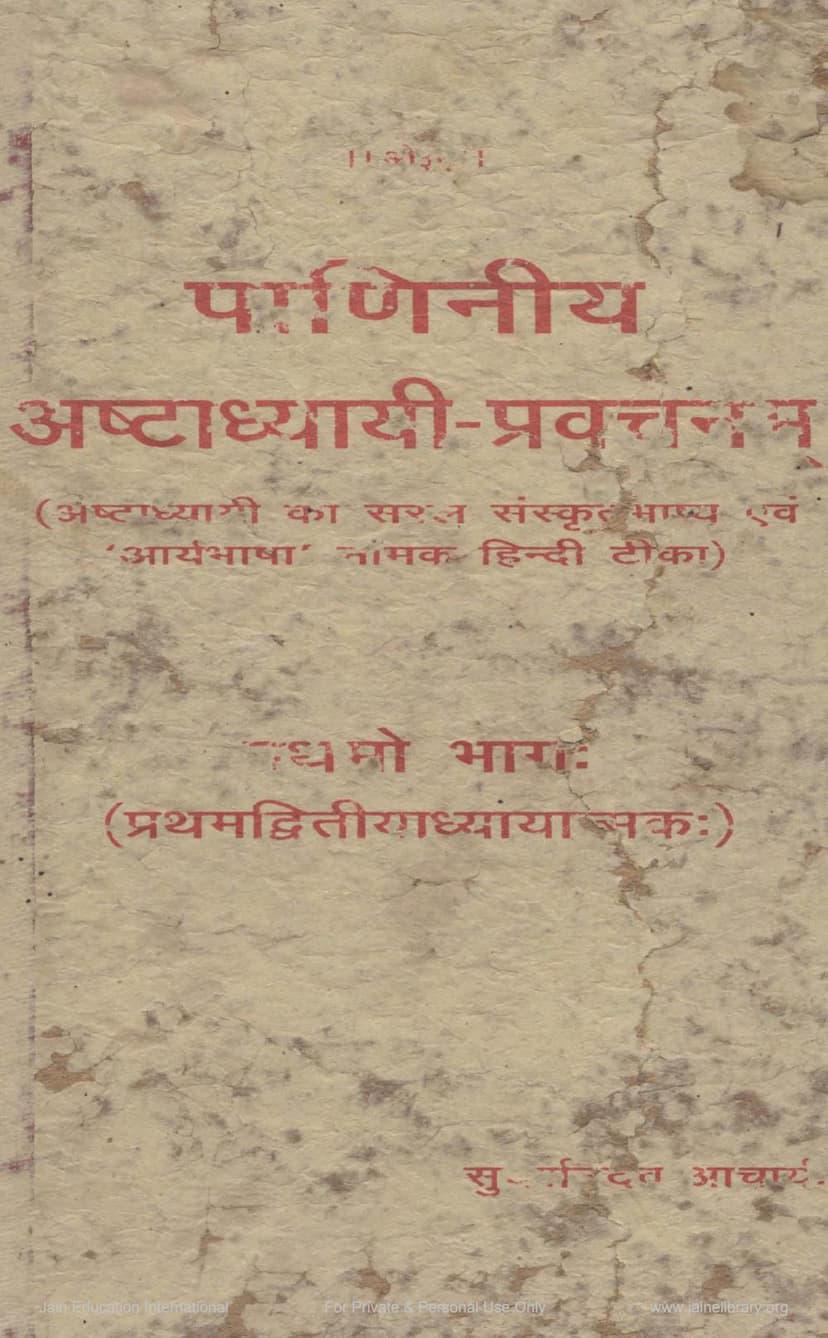Paniniya Ashtadhyayi Pravachanam Part 01
Added to library: September 2, 2025

Summary
Here's a comprehensive summary of the Jain text "Paniniya Ashtadhyayi Pravachanam Part 01" by Sudarshanacharya, based on the provided pages:
Book Title: Paniniya Ashtadhyayi Pravachanam Part 01 Author: Sudarshanacharya Publisher: Bramharshi Swami Virjanand Arsh Dharmarth Nyas Zajjar Catalog Link: https://jainqq.org/explore/003296/1
Overview:
This book is the first part of a commentary on Panini's Ashtadhyayi, a foundational text of Sanskrit grammar. The commentary includes a simple Sanskrit exposition (Bhashya) of Panini's sutras and an interpretation in Hindi titled 'Aryabhasha'. This first volume covers the first two chapters of the Ashtadhyayi.
Content and Structure:
The book begins with traditional invocations and salutations to Panini and the lineage of scholars. It then embarks on a detailed explanation of the grammatical concepts presented in the initial chapters of the Ashtadhyayi. The structure is organized by chapters and sections (padas) of the Ashtadhyayi.
Key Topics Covered in Part 1 (Chapters 1 & 2):
The provided pages give a detailed table of contents, outlining the vast array of topics covered in this volume. These include:
- Introduction to Grammar: The book starts with the auspicious beginning of the grammar discipline and introduces the concept of 'Shabdanushasanam' (the discipline of words).
- Prakriyas (Processes/Mechanisms):
- Pratyahara Sutras (Phonetic Grouping): A significant portion is dedicated to explaining the 14 Maheswara Sutras (also known as Pratyahara Sutras) which are fundamental to Panini's system. These sutras are crucial for understanding how sounds are grouped for subsequent rules. The book lists the 14 sutras and the resulting 41 pratyaharas (phonetic groupings).
- Varnamala (Alphabet): A section on the Sanskrit alphabet, including vowels (swaras), consonants (vyanjan), and other categories (ayovah), is presented.
- Sanjna Prakaranas (Designations/Classifications): The text delves into the crucial concept of grammatical designations (sanjnas) that are essential for understanding Panini's rules. This includes:
- Vriddhi Sanjna: Rules for lengthening vowels (Vriddhi).
- Guna Sanjna: Rules for vowel modifications (Guna).
- It Sanjna: Rules for the elision of certain letters.
- Savarna Sanjna: Rules for letters that have the same place and effort of articulation.
- Pragrihya Sanjna: Rules for certain vowels that remain unchanged.
- Ghu Sanjna: A designation for certain roots.
- Gh Sanjna: Another designation for certain roots.
- Nishta Sanjna: Designating the past passive participles (kta and ktavatu).
- Sarvanama Sanjna: Designation for pronouns.
- Avyaya Sanjna: Designation for indeclinable words.
- Sarvanama-sthana Sanjna: A special designation related to pronouns.
- Vibhasha Sanjna: Designation for optionality (choice between two possibilities).
- Samprasaran Sanjna: A phonetic process.
- Agam Vidhi: Rules for the insertion of sounds.
- Adesh Prakaran: Rules for substitution of sounds.
- Sthanivat Prakaran: Rules for treating a substituted sound as if it were the original.
- Lopa Prakaran: Rules for elision.
- T, Upadha: Designation for the last vowel of a root and the penultimate vowel.
- Word Formation (Taddhita): The initial chapters also lay the groundwork for word formation through taddhita suffixes.
- Samasa (Compounding): A substantial part of the first volume is dedicated to the rules of compound words (Samasa), including:
- Avyayibhav Samasa: Compounds where the first element is an indeclinable.
- Tatpurusha Samasa: Compounds where the first element is in a case relationship with the second. This section is quite extensive, covering various types of Tatpurusha compounds like:
- Ditiyatatpurusha (second case relationship)
- Tritiyatatpurusha (third case relationship)
- Chaturthitatpurusha (fourth case relationship)
- Panchamitpurusha (fifth case relationship)
- Saptamitpurusha (seventh case relationship)
- Samadhikarana Tatpurusha (comprising Karmadharaya and Upapada Samasa)
- Karmadharaya Samasa: A type of Tatpurusha where the first element qualifies the second.
- Upasarga Samjna: Designation for prefixes.
- Gati Samjna: Designation for words that function like prefixes in certain contexts.
- Karma Pravachaniya Samjna: Designation for certain prepositions that govern specific case endings.
- Introduction to Panini: The book also includes a biographical introduction to Panini, discussing his names, lineage, possible time period, and other significant works besides the Ashtadhyayi. It highlights the reverence shown to Panini by later grammarians like Katyayana and Patanjali, and by Western scholars.
- History of Ashtadhyayi Study: The text also touches upon the history of the study and revival of the Ashtadhyayi, mentioning prominent figures like Swami Purnanand Saraswati and Swami Virjanand Saraswati, and their role in promoting the study of Panini's grammar over more simplified, later texts like Siddhanta Kaumudi. The influence of Swami Dayanand Saraswati, a disciple of Swami Virjanand, in reviving the study of the Ashtadhyayi and Mahabhashya is also discussed.
Commentary Style:
The commentary by Dr. Sudarshan Dev Acharya aims to simplify and clarify Panini's intricate sutras. It provides a Sanskrit explanation with grammatical analysis (padachhed, vibhakti, samasa, anvaya, artha) and a Hindi explanation ('Aryabhasha') that further elucidates the meanings and provides examples with their step-by-step derivations (kacchi siddhi).
Overall Impression:
This volume is a scholarly and comprehensive attempt to make Panini's Ashtadhyayi accessible to a wider audience. It adheres to the traditional interpretative methods while providing clarity through Hindi explanations and examples. The book emphasizes the importance of the original Sanskrit grammatical tradition and the Arsha (ancient) texts. The introduction and historical notes highlight the deep respect and significance accorded to Panini's work in the history of linguistics and philosophy.